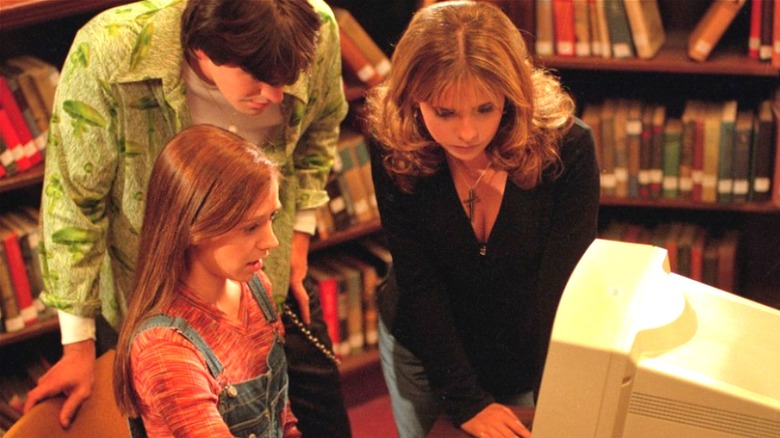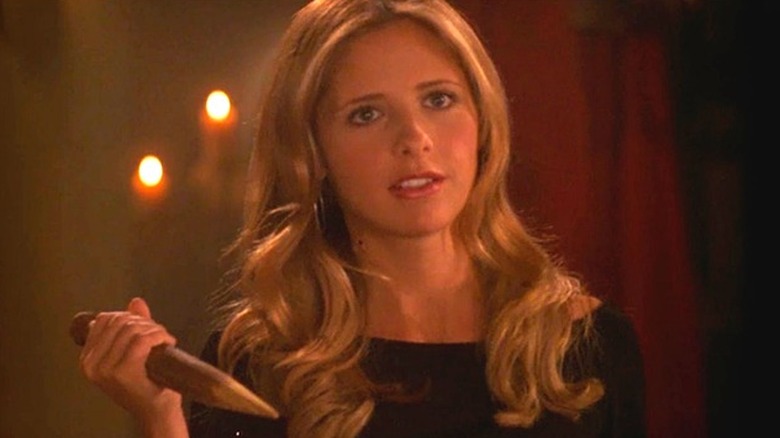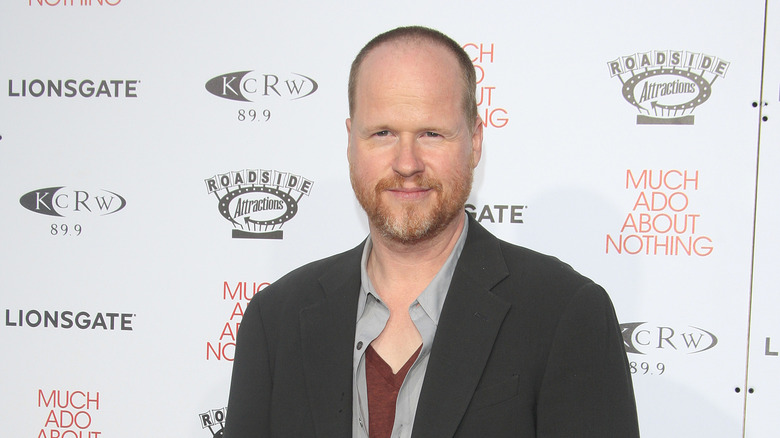Joss Whedon Created An Animated Buffy The Vampire Slayer Concept That Never Got Picked Up
Joss Whedon and the team behind "Buffy the Vampire Slayer" had eyes way bigger than their stomachs when cranking out seven preliminary scripts for "Buffy: The Animated Series." Voiced by almost the whole original cast, "The Animated Series" baited many young Buffy fans with a short, four-minute teaser episode showcasing a scantily-clad Buffy (voiced by Giselle Loren and NOT Sarah Michelle Gellar), fighting a vampire, chatting with Willow, Xander, and Giles in the library, and subsequently fighting a dragon.
"The Animated Series" was obviously informed by its live-action predecessor, bringing with it the actors' speaking voices, costume design, sexual innuendos, and toxic masculinity, even in Buffy herself. While it rings true to Whedon's vision for the show (probably a bit too much), you would think that he would have taken a little bit of time to course-correct.
In both iterations of the show, Xander (Nicholas Brendon) and Giles (Anthony Head) are ready to diminish any personal woes going on with Willow (Alyson Hannigan), Cordelia (Charisma Carpenter), or Buffy that aren't on the topic of monsters, the Hellmouth, or Xander's own sexual strife. His desperate, unrequited love for Buffy and his haphazard layering of short-sleeved button-downs make a prominent appearance in the 4.5-minute episode.
They also make sure to trivialize any potential conflicts between female characters. They pit Willow and Cordelia against each other before we're even introduced to Cordelia in the animated pilot. Both Giles and Xander mock Willow about how something as seemingly innocuous as wearing the same red skirt to a party could have a larger, more negative impact on her. Even though both Willow and Cordelia's characters are presented pretty much at face value, the show fails to recognize the intricate social dynamics of high school parties, academic pressure, and the interactions between shy, queer-coded Willow and abrasive, Queen Bee-coded Cordelia
'Open vamp, insert stake'
To balance out Buffy's male-gaze-fueled costuming, they made sure to arm her with enough masculine energy for everyone. Buffy is a hyper-independent, sassy, sarcastic vampire hunter, but it seems that Whedon prefers to take generically good-looking, potential damsels in distress and then equip them with the right amount of masculine edge to let them live/prevail, as opposed to leaning into their power as feminine beings. Buffy staking vampires through the heart is read as a phallic extension of herself, showing that even though her own agility may fail, at least she has the auxiliary help of a wooden stick to make her ultimately powerful as Sunnyvale's protector.
In episode 1 of "Buffy: The Animated Series," when recounting the previous night when she defeated a vampire, she discusses this defeat as though it were a one-night stand; a conquest whom she easily encountered, assessed, and defeated. She explains to her peers that it's as easy as "open vamp, insert stake." Buffy did exactly what she had to do, but it's hard to ignore the parallels the creator was trying to draw here. It's also clear that Whedon believes that the arsenal of tools and skills at the disposal of our titular character and her friends are fairly amateur when stacked against a more traditional, violent, masculine approach.
'I realized how easy an experience it can be...'
In a 2012 interview with Assignment X, Joss Whedon disparages his own show, saying:
"'Buffy' is the least frightening and least exciting action horror show ever. Face it, it's a soap opera with fangs. I would be like, 'okay, two cameras, go, we'll cut some of the gags, great.'"
He then goes on to describe his confusion that no one wanted to purchase the animated series.
"We got to do almost everything we wanted to do [...] The only thing we didn't get to do is an animated version, which was a delight for us because the writers themselves were working on it. We wrote seven scripts [...] it was 'what could we not do [on the regular series].' They were really fun to write. We could not sell the show. We could not sell an animated 'Buffy,' which I still find incomprehensible."
His commentary underplays some of his most feminine, "girl-power"-esque work, equating fighting hellish monsters while attending school full-time to a soap opera. His subsequent shock about the show's failed launch seems a bit transparent to me. If you don't believe in the strength of your characters, even with your own hand holding the pen, don't be surprised when no one else believes in it either.
Even Buffy herself, '90s scream queen Sarah Michelle Gellar, didn't want to work with Whedon again when given the opportunity. In a 2022 interview, during the "Power of Storytelling: Producers Roundtable" at the TheWrap's Power of Women Summit in Los Angeles, Gellar spoke about the rampant toxic masculinity on the set of "Buffy" during her time on the show:
"For so long, I was on a set that I think was known for being an extremely toxic male set, and so that was ingrained in my head that that was what all sets were like, and that women were pitted against each other — that if women became friends, then we became too powerful, so you had to keep that down [...] And now that I've had this opportunity to work with so many more women and men that support women as well, I realized how easy an experience it can be..."


